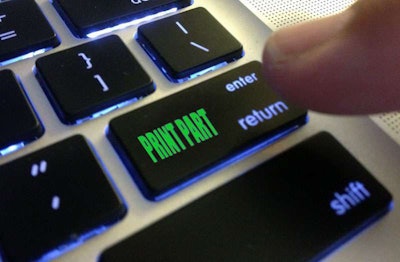
Just Hit “Print” For Parts
It’s almost quitting time on Friday when one of your mechanics calls in from the field: The front yoke on the driveshaft of a truck has split it needs replacing to get back in service. Every hour of downtime means lost revenue.
Neither your parts department nor the local dealer has this particular part in stock. It’ll be Monday before one can arrive for the fix.
Not a big deal. A couple taps on your iPad calls up the truck’s VIN and the CAD drawing of the part needed.
You hit “print” and an hour later the new part is pulled off a 3D laser printer in the parts department and sent on its way to the mechanic.
A few feet away a metal laser printer had just finished building a compressor wheel and turbo housing for an 15-year-old piece of equipment, while another model printer was quietly transforming tiny plastic beads into faceplates for a bank of light switches being installed on several new trucks.
Just hit “PRINT.” (WATCH VIDEO)
That could very well be the future of parts departments, body shops and service bays as advancements in 3D printer technology moves at a remarkable pace.
Far fetched? Not in the least.
For the price of a mid-level tire-changing machine, $4,999, a shop can already have a 3D printer from Boston-based Mark One that makes carbon-fiber parts, tooling and fixtures.
It’s a very basic machine that’s the tip of a huge market with dozens of brands spanning a wide range of technology, features and prices.
All types of automakers and aftermarket parts suppliers are already using 3D Direct Metal Laser Sintering (DMLS) and Fused Deposit Modeling (FDM) printers in design and manufacturing.
The big question is if/when vehicle manufacturers will release proprietary CAD drawings of parts so anyone with a 3D printer can produce their own replacement parts using FDM or DMLS systems.
I think we’ll see this happen for parts that don’t have a direct connection with occupant safety. How soon it happens is left to the vehicle manufacturers – or some company that can take parts and turn them into CAD drawings for printers to replicate.
When that happens, it won’t be long before future generations of 3D printers will be commonplace in repair shops and in the garages of serious DIYers who can’t afford to wait to get the parts they need.
When they need a part, they’ll just hit “PRINT.”








